歇后语的翻译
歇后语(含相关语)的翻译

The fairest rose is at last withered. 最美的玫瑰也终会凋谢—花无百日红 The darkest hour is that before the dawn. 黎明之前是最黑暗的时刻—否极泰来 The best fish swim near the bottom. 好鱼总在水底游;好酒沉瓮底—珍贵的东西不易 得 A blind man will not thank you for a lookingglass. 秋波送盲—白费痴情 A close mouth catches no flies. 病从口入—祸从口出 A fox may grow grey, but never good. 狐狸会变—但本性难移
歇后语的定义
歇后语及意思解释
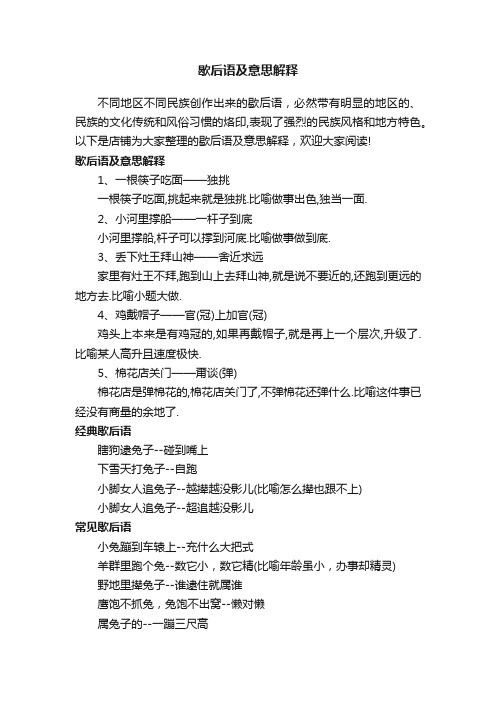
歇后语及意思解释不同地区不同民族创作出来的歇后语,必然带有明显的地区的、民族的文化传统和风俗习惯的烙印,表现了强烈的民族风格和地方特色。
以下是店铺为大家整理的歇后语及意思解释,欢迎大家阅读!歇后语及意思解释1、一根筷子吃面——独挑一根筷子吃面,挑起来就是独挑.比喻做事出色,独当一面.2、小河里撑船——一杆子到底小河里撑船,杆子可以撑到河底.比喻做事做到底.3、丢下灶王拜山神——舍近求远家里有灶王不拜,跑到山上去拜山神,就是说不要近的,还跑到更远的地方去.比喻小题大做.4、鸡戴帽子——官(冠)上加官(冠)鸡头上本来是有鸡冠的,如果再戴帽子,就是再上一个层次,升级了.比喻某人高升且速度极快.5、棉花店关门——甭谈(弹)棉花店是弹棉花的,棉花店关门了,不弹棉花还弹什么.比喻这件事已经没有商量的余地了.经典歇后语瞎狗逮兔子--碰到嘴上下雪天打兔子--自跑小脚女人追兔子--越撵越没影儿(比喻怎么撵也跟不上)小脚女人追兔子--超追越没影儿常见歇后语小兔蹦到车辕上--充什么大把式羊群里跑个兔--数它小,数它精(比喻年龄虽小,办事却精灵)野地里撵兔子--谁逮住就属谁鹰饱不抓兔,兔饱不出窝--懒对懒属兔子的--一蹦三尺高八月十五看龙灯--迟了大半年(比喻太晚来不及了)唱戏的穿龙袍--成不了皇帝大水冲了龙王庙--家人不认识一家人(比喻自己人由于互不了解发生了冲突、误会)河里划龙船--同心协力跤龙头上搔痒--溜须不要命歇后语及意思解释不同地区不同民族创作出来的歇后语,必然带有明显的地区的、民族的文化传统和风俗习惯的烙印,表现了强烈的民族风格和地方特色。
以下是店铺为大家整理的歇后语及意思解释,欢迎大家阅读! 歇后语及意思解释 1、一根筷子吃面独挑一推荐度:点击下载文档文档为doc格式。
成语俗语歇后语翻译
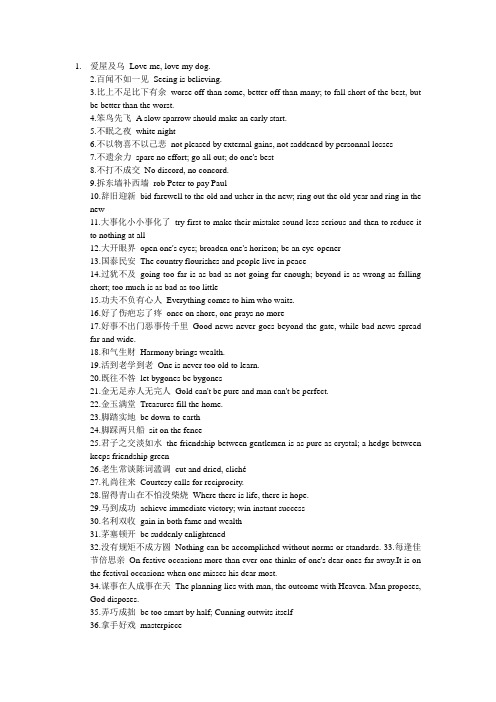
1.爱屋及乌Love me, love my dog.2.百闻不如一见Seeing is believing.3.比上不足比下有余worse off than some, better off than many; to fall short of the best, butbe better than the worst.4.笨鸟先飞A slow sparrow should make an early start.5.不眠之夜white night6.不以物喜不以己悲not pleased by external gains, not saddened by personnal losses7.不遗余力spare no effort; go all out; do one's best8.不打不成交No discord, no concord.9.拆东墙补西墙rob Peter to pay Paul10.辞旧迎新bid farewell to the old and usher in the new; ring out the old year and ring in thenew11.大事化小小事化了try first to make their mistake sound less serious and then to reduce itto nothing at all12.大开眼界open one's eyes; broaden one's horizon; be an eye-opener13.国泰民安The country flourishes and people live in peace14.过犹不及going too far is as bad as not going far enough; beyond is as wrong as fallingshort; too much is as bad as too little15.功夫不负有心人Everything comes to him who waits.16.好了伤疤忘了疼once on shore, one prays no more17.好事不出门恶事传千里Good news never goes beyond the gate, while bad news spreadfar and wide.18.和气生财Harmony brings wealth.19.活到老学到老One is never too old to learn.20.既往不咎let bygones be bygones21.金无足赤人无完人Gold can't be pure and man can't be perfect.22.金玉满堂Treasures fill the home.23.脚踏实地be down-to-earth24.脚踩两只船sit on the fence25.君子之交淡如水the friendship between gentlemen is as pure as crystal; a hedge betweenkeeps friendship green26.老生常谈陈词滥调cut and dried, cliché27.礼尚往来Courtesy calls for reciprocity.28.留得青山在不怕没柴烧Where there is life, there is hope.29.马到成功achieve immediate victory; win instant success30.名利双收gain in both fame and wealth31.茅塞顿开be suddenly enlightened32.没有规矩不成方圆Nothing can be accomplished without norms or standards. 33.每逢佳节倍思亲On festive occasions more than ever one thinks of one's dear ones far away.It is on the festival occasions when one misses his dear most.34.谋事在人成事在天The planning lies with man, the outcome with Heaven. Man proposes,God disposes.35.弄巧成拙be too smart by half; Cunning outwits itself36.拿手好戏masterpiece37.赔了夫人又折兵throw good money after bad38.抛砖引玉a modest spur to induce others to come forward with valuable contributions; throw a sprat to catch a whale39.破釜沉舟cut off all means of retreat;burn one…s own way of retreat and be determined to fight to the end40.抢得先机take the preemptive opportunities41.巧妇难为无米之炊If you have no hand you can't make a fist. One can't make bricks without straw.42.千里之行始于足下a thousand-li journey begins with the first step--the highest eminence is to be gained step by step43.前事不忘后事之师Past experience, if not forgotten, is a guide for the future. 44.前人栽树后人乘凉One generation plants the trees in whose shade another generation rests.One sows and another reaps.45.前怕狼后怕虎fear the wolf in front and the tiger behind hesitate in doing something46.强龙难压地头蛇Even a dragon (from the outside) finds it hard to control a snake in its old haunt - Powerful outsiders can hardly afford to neglect local bullies.47.强强联手win-win co-operation48.瑞雪兆丰年A timely snow promises a good harvest.49.人之初性本善Man's nature at birth is good.50.人逢喜事精神爽Joy puts heart into a man.51.人海战术huge-crowd strategy52.世上无难事只要肯攀登Where there is a will, there is a way.53.世外桃源a fictitious land of peace away from the turmoil of the world;54.死而后已until my heart stops beating55.岁岁平安Peace all year round.56.上有天堂下有苏杭Just as there is paradise in heaven, ther are Suzhou and Hangzhou on earth57.塞翁失马焉知非福Misfortune may be an actual blessing.58.三十而立A man should be independent at the age of thirty.At thirty, a man should be able to think for himself.59.升级换代updating and upgrading (of products)60.四十不惑Life begins at forty.61.谁言寸草心报得三春晖Such kindness of warm sun, can't be repaid by grass. 62.水涨船高When the river rises, the boat floats high.63.时不我待Time and tide wait for no man.64.杀鸡用牛刀break a butterfly on the wheel65.实事求是seek truth from facts; be practical and realistic; be true to facts66.说曹操,曹操到Talk of the devil and he comes.67.实话实说speak the plain truth; call a spade a spade; tell it as it is68.实践是检验真理的唯一标准Practice is the sole criterion for testing truth.69.山不在高,有仙则名'No matter how high the mountain is, its name will spread far and wide if there is a fairy; '70.韬光养晦hide one's capacities and bide one's time71.糖衣炮弹sugar-coated bullets72.天有不测风云Anything unexpected may happen. a bolt from the blue73.团结就是力量Unity is strength.74.“跳进黄河洗不清”'eve if one jumped into the Yellow River, one can not wash oneself clean--there's nothing one can do to clear one's name '75.歪风邪气unhealthy practices and evil phenomena76.物以类聚,人以群分Birds of a feather flock together.77.往事如风'The past has vanished (from memory) like wind.; What in past, is pas78.望子成龙hold high hopes for one's child79.屋漏又逢连阴雨Misfortunes never come singly. When it rains it pours.80.文韬武略military expertise; military strategy81.唯利是图draw water to one's mill82.无源之水,无本之木water without a source, and a tree wiithout roots83.无中生有make create something out of nothing84.无风不起浪There are no waves without wind. There's no smoke without fire. 85.徇私枉法bend the law for the benefit of relatives or friends86.新官上任三把火a new broom sweeps clean87.虚心使人进步,骄傲使人落后Modesty helps one go forward, whereas conceit makes one lag behind.88. 蓄势而发accumulate strength for a take-off89.心想事成May all your wish come true90.心照不宣have a tacit understanding; give tacit consent; tacit understanding 91.先入为主First impressions are firmly entrenched.92.先下手为强catch the ball before the bound93.像热锅上的蚂蚁like an ant on a hot pan94.现身说法warn people by taking oneself as an example95.息事宁人pour oil on troubled waters96.喜忧参半mingled hope and fear97.循序渐进step by step98.一路平安,一路顺风speed somebody on their way; speed the parting guest99.严以律己,宽以待人be strict with oneself and lenient towards others100鱼米之乡101.有情人终成眷属'Jack shall have Jill, all shall be well.'102.有钱能使鬼推磨Money makes the mare go. Money talks.103. 有识之士people of vision104.有勇无谋use brawn rather than brain105.有缘千里来相会Separated as we are thousands of miles apart, we come together as if by predestination.106.与时俱进advance with times107.以人为本people oriented; people foremost108.因材施教teach students according to their aptitude109.欲穷千里目,更上一层楼'to ascend another storey to see a thousand miles further; Ascend further, were you to look farther; Would eye embrace a thousand miles? Go up, one flight.' a land of milk and honey110.欲速则不达Haste does not bring success.111. 优胜劣汰survival of the fittest112.英雄所见略同Great minds think alike.113.冤家宜解不宜结Better make friends than make enemies.114.冤假错案'cases in which people were unjustly, falsely or wrongly charged or sentenced;unjust, false or wrong cases'115.一言既出,驷马难追A real man never goes back on his words.116.招财进宝Money and treasures will be plentiful117.债台高筑become debt-ridden118.致命要害Achilles' heel119. 众矢之的target of public criticism120.知己知彼,百战不殆Know the enemy and know yourself, and you can fight a hundred battles with no danger of defeat.121. 纸上谈兵be an armchair strategist122.纸包不住火Truth will come to light sooner or later.123.左右为难between the devil and the deep blue seaLanguage is a door, through which we may walk closer to success;Language is a window, out of which we can see a colorful life;Language is a mirror, in which we can find both others and ourselves.俗话说“慢功出细活”,英谚又云“More haste, less speed(欲速则不达)”。
英语歇后语

英语经典歇后语精选1、 Bad news has wings.好事不出门,坏事传千里。
2、 Barking dogs seldom bite.吠犬不咬人。
3、Beauty lies in the love‘s eyes.情人眼里出西施。
4、 Be swift to hear, slow to speak.听宜敏捷,言宜缓行。
5、 Better late than never.不怕慢,单怕站。
6、 Better to ask the way than go astray.问路总比迷路好。
7、 Between friends all is mon.朋友之间不分彼此。
8、 Birds of a feather flock together.物以类聚,人以群分。
9、 Blood is thicker than water.血浓于水。
10、 Blood will have blood.血债血偿。
11、 Books and friends should be few but good. 读书如交友,应求少而精。
12、 Business is business.公事公办。
13、 Business is the salt of life.事业是人生的第一需要。
14、 By reading we enrich the mind, by conversation we polish it.读书使人充实,交谈使人精明。
15、 Cannot see the wood for the trees.一叶障目,不见泰山。
16、 Care and diligence bring luck.慎重和勤奋才能抓住机遇。
17、 Caution is the parent of safety.小心驶得万年船。
18、 Cheats never prosper.骗人发不了财。
19、 Children are what the mothers are.耳濡目染,身教言传。
歇后语翻译
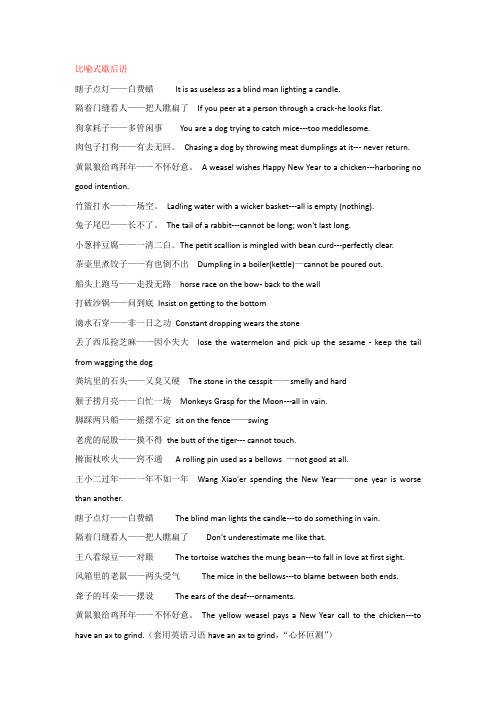
比喻式歇后语瞎子点灯——白费蜡It is as useless as a blind man lighting a candle.隔着门缝看人——把人瞧扁了If you peer at a person through a crack-he looks flat.狗拿耗子——多管闲事You are a dog trying to catch mice---too meddlesome.肉包子打狗——有去无回。
Chasing a dog by throwing meat dumplings at it--- never return.黄鼠狼给鸡拜年——不怀好意。
A weasel wishes Happy New Year to a chicken---harboring no good intention.竹篮打水——一场空。
Ladling water with a wicker basket---all is empty (nothing).兔子尾巴——长不了。
The tail of a rabbit---cannot be long; won't last long.小葱拌豆腐——一清二白。
The petit scallion is mingled with bean curd---perfectly clear.茶壶里煮饺子——有也倒不出Dumpling in a boiler(kettle)—cannot be poured out.船头上跑马——走投无路horse race on the bow- back to the wall打破沙锅——问到底Insist on getting to the bottom滴水石穿——非一日之功Constant dropping wears the stone丢了西瓜捡芝麻——因小失大lose the watermelon and pick up the sesame - keep the tail from wagging the dog粪坑里的石头——又臭又硬The stone in the cesspit——smelly and hard猴子捞月亮——白忙一场Monkeys Grasp for the Moon---all in vain.脚踩两只船——摇摆不定sit on the fence——swing老虎的屁股——摸不得the butt of the tiger--- cannot touch.擀面杖吹火——窍不通 A rolling pin used as a bellows —not good at all.王小二过年——一年不如一年Wang Xiao'er spending the New Year——one year is worse than another.瞎子点灯——白费蜡The blind man lights the candle---to do something in vain.隔着门缝看人——把人瞧扁了Don’t underestimate me like that.王八看绿豆——对眼The tortoise watches the mung bean---to fall in love at first sight.风箱里的老鼠——两头受气The mice in the bellows---to blame between both ends.聋子的耳朵——摆设The ears of the deaf---ornaments.黄鼠狼给鸡拜年——不怀好意。
收集名人名言歇后语

歇后语:1、鼻孔里灌米汤——够受的。
2、炒了的虾米——红人(仁)。
3、冬瓜皮做甑子——不争(蒸)气。
4、外甥打灯笼——照旧(舅)。
5、孔夫子搬家——净是输(书)。
6、梁山泊的军师——无(吴)用。
7、咸菜烧豆腐——有言(盐)在先。
8、百日不下雨——久情(晴)。
9、老爷下轿——不(步)行。
10、大胖小子抓周——小人得志。
名人名言:1、学而不厌,诲人不倦。
——先秦·孔子《论语·述而篇》翻译:努力学习而从不满足,教导别人而不知疲倦。
2、天将降大任于是人也,必先苦其心志,劳其筋骨,饿其体肤,空乏其身,行拂乱其所为。
——先秦·孟子《孟子·告子章句下·第十五节》翻译:所以上天要把重任降临在某人的身上,必定要先使他的内心痛苦,使他的筋骨劳累,使他经受饥饿之苦,以致肌肤消瘦,使他受贫困之苦,扰乱其人业已开始的行动。
3、丈夫志四海,万里犹比邻。
——三国·曹植《赠白马王彪》翻译:大丈夫志在四海,即使相隔万里也好像就在身边一样。
4、只要功夫深,铁杵磨成针。
——宋·祝穆《方舆胜览·眉州·磨针溪》翻译:只要有决心,肯下功夫,铁杵也能磨成针,比喻多么难的事也能做成功。
5、一寸光阴一寸金,寸金难买寸光阴。
——《增广贤文·上集》翻译:一寸光阴和一寸长的黄金一样昂贵,而一寸长的黄金却难以买到一寸光阴。
比喻时间十分宝贵。
6、其身正,不令而行;其身不正,虽令不从。
——先秦·孔子《论语·子路篇》翻译:当管理者自身端正,作出表率时,不用下命令,被管理者也就会跟着行动起来;相反,如果管理者自身不端正,而要求被管理者端正,那么,纵然三令五申,被管理者也不会服从的。
7、尺有所短,寸有所长;物有所不足,智有所不明;数有所不逮,神有所不通。
——先秦·屈原《卜居》翻译:所谓尺有它不足的地方,寸有它的长处;物有它不足的地方,智慧有它不能明白的问题;卦有它算不到的事,神有它显不了灵的地方。
歇后语的翻译

朱漪涟 袁海晴 郁雯
导读:
根据歇后语的特点,一般分为比喻性歇后 语和双关性歇后语。英译时可采用的方法 大致有直译,借用,意译等方法,具体的 翻译还要结合原文的背景以及讲话者的身 份采取适当的变通。
一、比喻性歇后语
比喻性歇后语就是通过比喻这一修辞手法 来说明道理。
Examples:
1、他们是兔子的尾巴——长不了 译:They're like a rabbit tail——they can't grow any bigger.(直译) 2、姨奶奶犯不着来骂我,我又不是姨奶奶家买的。梅香拜 把子——都是奴才罢咧!(出自红楼梦) 译:You've no call to swear at me ,mandam.You didn't buy me .We're all birds of a feather——-all slaves here .(借用) 3、狗咬吕洞宾——不识好人心 译:You snarl and snap at Lv Dongbin(one of the eight immortals in Chinese mythology)——wrong a kind -hearted person.(直译加注)
关于Cat
• A cat has nine lives.猫有九条命;吉人天 相。 • Cats hide their claws. 知人知面不知心。 • Care kill a cat. 忧虑愁死猫。 • The cat shuts its eyes when stealing crea m.掩耳盗铃。
谐音双关
Examples:
1,......再过几天,还不是外甥打灯笼---------照舅(旧) 译:Even in a few days things will be back to what they were before...
从直译和意译角度看歇后语的汉译日

从直译和意译角度看歇后语的汉译日
歇后语是汉语特有的一种语言表达形式,它以简洁的形式表达出深刻的哲理或幽默的玩味。
在翻译歇后语时,可以从直译和意译两个角度进行思考和处理。
直译是指尽量保持原文的意思和形式,一字不差地将歇后语翻译成另一种语言。
直译的优点是保持了原文的原汁原味,能够让原文的幽默感和玩味效果得以保留。
但直译也面临一些困难,因为不同语言有着不同的表达习惯和语法结构,直译可能会导致意思不明确或者难以理解。
直译“宝剑锋从磨砺出,梅花香自苦寒来”这句歇后语,可以直接翻译为“The sword is sharpened from grinding, and the plum blossom is fragrant from the cold。
”这个直译的版本保留了原文中的干练和优美,但可能会让英语读者感觉有些晦涩和难以理解。
而意译则是根据目标语言和文化背景的特点,对原文进行意思的转换和再创作,以更好地传达原文的含义和精神。
意译可以更注重目标语言的表达习惯和语言习惯,使译文更贴近读者的理解和接受。
但意译也需要注意保持原文的基本意思和特色,遵循译文贴近原文的原则。
翻译歇后语需根据实际情况灵活运用直译和意译的方法。
在一些需要保留原文特色和玩味效果的情况下,可以采用直译;在一些需要传达含义和易于理解的情况下,可以采用意译。
而无论使用哪种方法,都需要注重译文的流畅性、准确性和表达力,以达到传达原文的目的。
歇后语翻译

a lucky dog 幸运儿;an old dog 老手;Every dog has its day. 凡人皆有得意日。
He works like a dog. 他工作很努力。
Love me, love my dog. 爱屋及乌。
as wise as an owl 象猫头鹰一样聪明猫头鹰进宅, 好事不来He is a bear at maths (他是个数学天才)瞧他那个熊样儿‖、―真熊‖a poor fish 可怜虫a loose fish 生活放荡的女人fish in the air 水中捞月as busy as a ___bee___as slow as a ___snailas stubborn as a __muleas timid as a __hare___as strong as a __horse___as poor as a church ___mouse__A dog’s life 争吵不休,过着不安宁的日子Go to the dogs 每况愈下Dog-eat-dog 狗咬狗的,损人利己的Dog in the manger 站着茅坑不拉屎Dog days 大热天Doggy bag 餐馆里的打包袋Better be the head of a dog than the tail of a lion. 宁为鸡头,不为凤尾。
drink like a fish 牛饮tread upon eggs 如履薄冰胆小如鼠as timid as a rabbit/chicken-hearted狐假虎威an ass in a lion’s skin瓮中之鳖like a rat in a holelike a drenched chicken; like a drowned rat 落汤鸡rey mare 母老虎(比丈夫强的妻子)a green hand(生手,易上当受骗的人),green goods(新鲜货),a green man(新来水手),a green old age(老当益壮)等等。
歇后语的翻译

1)他必审问我,我给他个“徐庶入曹 营---一语不发”。
He’s sure to ask me questions but I’ll just hold my tongue.
2)狗咬吕洞宾---- 不识好人 心。
You snarl and snap at Lv Dongbin (one of the eight immortals in Chinese mythology) ---- wrong a kind-hearted person. 你别狗咬吕洞宾,不识好人心 • Don’t snap (猛咬)and snarl (龇牙低吼) at me when I’m trying to do my best for you.
3). 咱们是一条绳拴着两只蚂蚱, 谁也跑不了。
We’re like two grasshoppers tied to one cord (细绳): neither can get away.
4). 这简直是瞎子点灯白费蜡了。 It seemed as useless as a blind man lighting a candle.
2)您犯不着来骂我,我又不是您买了。咱们是 “梅香拜把子,---都是奴才罢咧。”
You have no right to scold me. You didn’t buy me. We’re all birds of a feather---all slaves here.
3) 老混蛋,你吃的河水,倒(道: 路)管得宽。
二、保留形象节译
有些歇后语的喻义比较明显,译语读者可从喻体的形象中 或歇后语所在的上下文中直接推知喻义,英译时可只需译 出比喻部分。
1). 他知道这是黄鼠狼给鸡拜年,没安好心。
歇后语的语言特点及其翻译
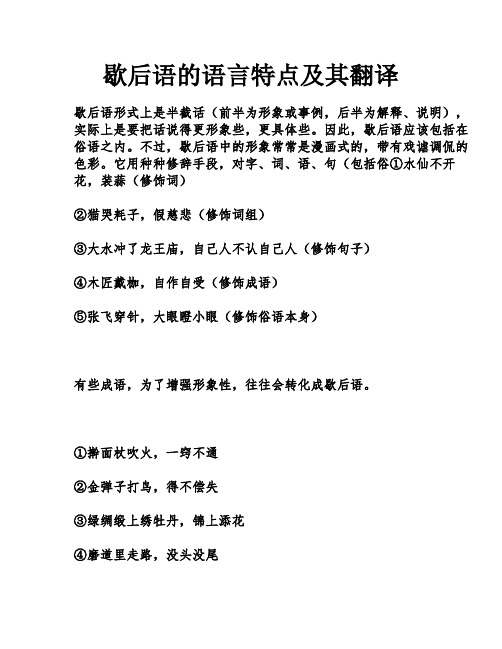
歇后语的语言特点及其翻译歇后语形式上是半截话(前半为形象或事例,后半为解释、说明),实际上是要把话说得更形象些,更具体些。
因此,歇后语应该包括在俗语之内。
不过,歇后语中的形象常常是漫画式的,带有戏谑调侃的色彩。
它用种种修辞手段,对字、词、语、句(包括俗①水仙不开花,装蒜(修饰词)②猫哭耗子,假慈悲(修饰词组)③大水冲了龙王庙,自己人不认自己人(修饰句子)④木匠戴枷,自作自受(修饰成语)⑤张飞穿针,大眼瞪小眼(修饰俗语本身)有些成语,为了增强形象性,往往会转化成歇后语。
①擀面杖吹火,一窍不通②金弹子打鸟,得不偿失③绿绸缎上绣牡丹,锦上添花④磨道里走路,没头没尾⑤螃蟹过河,七手八脚⑥十五个吊桶打水,七上八下⑦屎壳郎变知了,一步登天⑧小葱拌豆腐,一清二白⑨阎王爷出告示,鬼话连篇歇后语良莠不齐,有些歇后语内容和形象,均不见佳,有一部分,甚至是语言垃圾,不宜滥用。
有些常用的歇后语,形象较好,前后结合得比较紧密,已经跟谚语、描述性的俗语(俚语)近似。
如:①黄鼠狼看鸡,越看越稀(前为形象,后为解释,经验之谈→谚语)②竹篮子打水,一场空(前为形象,后为解释,描述性俗语→俚语)③芝麻开花,节节高(前为形象,后为解释,描述性俗语→俚语)语本身)加以修饰,使之生动活泼。
歇后语歇后语,是我们中国人特有的智慧与趣味语言,也是民间爱用的一种语法。
歇后语是广大人民在生活实践中创造的一种特殊语言形式。
它一般由两个部分构成,前半截是形象的比喻,象谜面,后半截是解释、说明,象谜底,十分自然贴切。
例如:一个巴掌打不响 -- <孤掌难鸣>;懒婆娘的裹脚 -- <又长又臭>。
在一般的语言中。
通常只要说出前半截,"歇"去后半截,就可以领会和猜出它的本意,所以称它为歇后语。
最早出现"歇后"这一名称的是在唐代。
《旧唐书。
郑綮列传》中就已提到过有所谓"郑五歇后体"(一种"歇后"体诗)。
成语谚语歇后语及习语的翻译
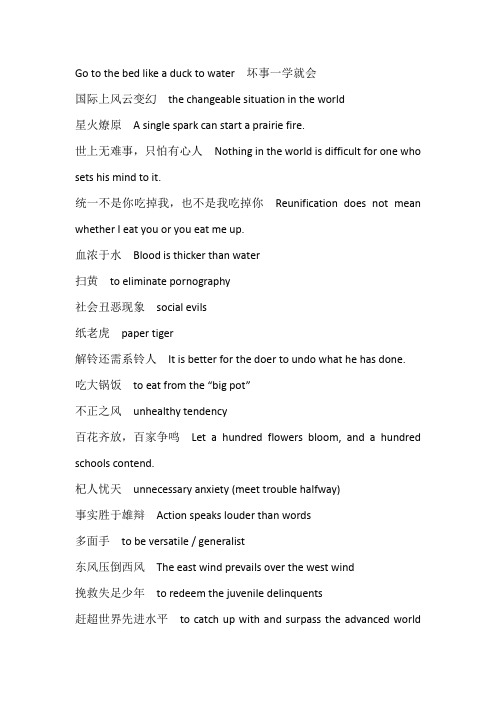
Go to the bed like a duck to water 坏事一学就会国际上风云变幻the changeable situation in the world星火燎原 A single spark can start a prairie fire.世上无难事,只怕有心人Nothing in the world is difficult for one who sets his mind to it.统一不是你吃掉我,也不是我吃掉你Reunification does not mean whether I eat you or you eat me up.血浓于水Blood is thicker than water扫黄to eliminate pornography社会丑恶现象social evils纸老虎paper tiger解铃还需系铃人It is better for the doer to undo what he has done.吃大锅饭to eat from the “big pot”不正之风unhealthy tendency百花齐放,百家争鸣Let a hundred flowers bloom, and a hundred schools contend.杞人忧天unnecessary anxiety (meet trouble halfway)事实胜于雄辩Action speaks louder than words多面手to be versatile / generalist东风压倒西风The east wind prevails over the west wind挽救失足少年to redeem the juvenile delinquents赶超世界先进水平to catch up with and surpass the advanced worldlevel过小康生活to lead a well-off life菜篮子工程“shopping basket” program计划生育family planning路遥知马力,日久见人心As a long road tests a horse’s strength, a long task pro ves a person’s heart. (Time reveals a person’s heart)酒不醉人人自醉It is not wine that intoxicates but the drinker who gets himself drunk.蜗居Pigeonhole; snail house小三The other woman (man)剩女3S lady (single, seventies, stuck)槁木死灰withered wood or cold ashes骨瘦如柴be lean as a rake对牛弹琴To cast pearl before swine众人拾柴火焰高Many hands make light work.竹篮打水一场空To draw water with a sieve挥金如土spend money like waterHoist your sail when the wind is fair. 好风扬快帆A small leak will sink a great ship. 小洞沉大船; 小患不治成大灾您(先)请!After you.前事不忘,后事之师Past experiences, if not forgotten, is a guide for the future. (Lessons learned from the past can serve as a guide in thefuture.)路遥知马力,日久见人心 A long road tests a horse’s strength and a long task proves man’s heart.树倒猢狲散Once the tree falls, the monkeys on it will flee helter-skelter.八仙过海,各显神通The Eight Fairies are the eight immortals of Taoism in Chinese folklore.半边天Half the sky暴发户Instant rich洗手不干Wash one’s hands out of a thing易拉罐Pop-top; pull-top红榜Honor roll垄断Monopoly旺季(淡季)High season/ low season杀手锏Sunday punch一个和尚挑水吃,两个和尚抬水吃,三个和尚没水吃。
歇后语的英文翻译

生活中常用的歇后语two-part allegorical saying--------------------------------------------------------------------------------茶壶里煮饺子——有也倒不出Dumpling in a boiler(kettle)—cannot be poured out.船头上跑马——走投无路horse race on the bow- back to the wall打破沙锅——问到底Insist on getting to the bottom滴水石穿——非一日之功Constant dropping wears the stone电线杆上绑鸡毛——好大的掸(胆)子Feathers tied on the pole----How dare it!丢了西瓜捡芝麻——因小失大lose the watermelon and pick up the sesame - keep the tail from wagging the dog粪坑里的石头——又臭又硬The stone in the cesspit——smelly and hard韩信点兵——多多益善Han Xin reviewed troops, the more the better.猴子捞月亮——白忙一场Monkeys Grasp for the Moon, all in vain.脚踩两只船——摇摆不定sit on the fence——swing老虎的屁股——摸不得the butt of the tiger, can not touch.聋子的耳朵——摆设Deaf ears——ornament一二三四五六七--- 忘(王)八One two three four five six seven---forget eight猪八戒戴耳环:自以为美Zhu Bajie wears the earring--pleased with himself.擀面杖吹火———一窍不通A rolling pin used as a bellows —not good at all.王小二过年——一年不如一年Wang Xiao'er spending the New Year——one year is worse than another. 灶王爷扔石头——砸锅The Kitchen God throwing stones——to break the pot or ruin the matter. 秦叔宝卖马——穷途末路Qin Shubao selling his horse——the last resort to overcome his difficulty 瞎子点灯--白费蜡。
汉语谚语和歇后语的翻译

翻译磨刀石
• • • • • • • • • • 敲竹杠 抱粗腿 连锅端 穿连裆裤 唱对台戏 开绿灯 泼冷水 唱反调 挖空心思 试金石
• • • • • • • • • • Overcharge/ fleece/ soak(俚语) Latch on the rich and powerful Get rid of the whole lot Work hand in clove with Put on rival show Give the green light Pour cold water on Sing a different tune Rack one’s brains Touchstone/ Lydian stone
• 他吗?棺材里伸出手来—死要钱。 • No, he is still after my blood. • 可是谭招弟心中却想:骑着毛驴看书—走着瞧吧, 看究竟是啥原因。 • But Tan Zhaodi was still thinking to herself, “Let’s wait and see what the reason for it turns out to be in the end.
对比:
• 路遥知马力,日久见人心。 • As a long road tests a horse’s strength, so a long task proves a person’s heart. • Time reveals a person’s heart. • 初生牛犊不怕虎。 • New-born calves make little of tigers. • Young people are fearless.
• 强中更有强中手。 • 新官上任三把火。 • 癞痢头儿子自家好。
关于歇后语的翻译(ppt 19页)
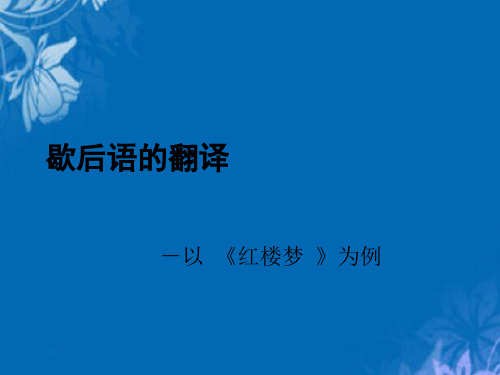
• 这种表达意义的特点,与英语中的wise crack 有异曲 同工之妙,这可以根据英语词典里对这个词语的定义 看出:wise crack n. (informal) smart or clever (often unkind) saying or remark 俏皮话;(常指)风凉话 (《牛津高级英汉双解词典》,1997);wise crack n. a clever or sarcastic remark (《韦氏大学英语词典》 1996)。
• 给歇后语一个合适的英语名称真的就没有可 能吗?鉴于以上方法的困境,给歇后语英文 命名恐怕只好另辟蹊径―从歇后语的本质内 容出发,找出一个定性的译名(类似英语习 语idiom中的俗语colloquialism,格言motto, 谚语proverb,俚语slang,名言sayings等的 命名方法)。
• 但是这样一个解释,虽然比较完备地说明了歇后语是 什么,却不合适作为命名(Naming)。因此,出于 无奈之际,有人就干脆用汉语的拼音“xie hou yu”称 之。只是这样一来,英语读者始终无法了然这是怎样 一类修辞格,他们的头脑中无法形成一种概念,一种 期待,无法像汉语人那样一看到这个词眼,就能联想 起这一特点鲜明、极富感染力的语言形式。
• 有学者因此将其定名为“Chinese folk wise cracks”。 这样就从内容、语体等方面说明了歇后语的本质,也
符合命名的标准,比较容易为读者接受。故我们也采 用这种说法—把汉语歇后语的英译名定为“Chinese folk wise cracks”。
- 1、下载文档前请自行甄别文档内容的完整性,平台不提供额外的编辑、内容补充、找答案等附加服务。
- 2、"仅部分预览"的文档,不可在线预览部分如存在完整性等问题,可反馈申请退款(可完整预览的文档不适用该条件!)。
- 3、如文档侵犯您的权益,请联系客服反馈,我们会尽快为您处理(人工客服工作时间:9:00-18:30)。
解释性增补
解释性增补是指当源语中词语的内涵意义在 译语中出现词汇空缺,其联想意义也出现空白 时,译者必须保留源语的词语形象,而将其深层 含义以解释的形式翻译出来,揭示出源语的文 化特性或文化背景。 汉语中特有的歇后语在译成英语时,可以保留 原语形象,再用解释性增补以表现其喻意。
利用汉语的谐音
竹篮打水--一场空。 Like ladling water with a wicker basket-all is empty (nothing). 八仙过海--各显其能。 (Like) the Eight Immortals crossing the seaeach showing his or her special prowess. ( Each of them shows their true worth.)
利用双关语义
井底雕花——深刻 carving a flower design on the bottom of a well——carving deeply or get to the essence of something
擀面杖吹火———一窍不通 a rolling pin used as a bellows —no good at all
Note: Wang Xizhi was a famous Chinese calligrapher and a Chinese character is usually composed of strokes, of which the vertical and horizontal ones are the most commonly used. Hengshu here has two interpretations: 1) the horizontal and vertical strokes; 2) horizontally or vertically, that is, in any way.
白骨精骗唐僧——一计不成又生一计 the White Bone Demon deceiving Monk Tang——when one scheme failed, she turned to another; like the White Bone Demon in trapping Xuanzang, a famous monk from the Tang Dynasty, they have thought out one scheme after another
灶王爷扔石头——砸锅 the Kitchen God throwing stones——to break the pot or ruin the matter
Note: The literal meaning of zaguo is to break a pot but it is usually used to mean ruining the matter.
铁打的馒头——一个硬似一个 mantou made of iron——one harder than another; they are like steamed bread made of iron, one is harder, more stubborn or determined than another 热锅上的蚂蚁——走投无路 ants in a hot pot——nowhere to escape; like ants in a hot pot, they find nowhere to escape
歇后语的分类
歇后语的数量很多,一本《中国歇后语》 (1988,上海文艺版)就收入了15万条的歇后 语,因此歇后语的分类方法也不是唯一的。 根据前后两部分的联系可将歇后语分为比喻 性歇后语和谐音或双关式歇后语两大类
比喻性歇后语:
谐音或双关式歇后语:
章鱼的肚子--有墨水(语意关 联)
飞机上跳伞——一落千丈
bale out from a flying plane——drop down a thousand zhang or suffer a drastic decline; like jumping from a flying plane, they decline drastically Note: A zhang is equal to 11/3 meters.
解释法:解释法是一种行之有效的翻译方法, 也是揭示源语文化内涵的重要途径,它是指在 译文里保留原来的文化色彩,并加上简要的解 释说明以突出其形象性。 解释法可以细分为解释性替代和解释性增补 两种类型。
解释性替代
解释性替代是指当词语在源语和译语中的内 涵意义相同,但联想意义不同时,不能按照字面 翻译,而应该用解释性替代的方法翻译原文。 汉语中的成语即谚语翻译一般用解释性替代 的方法来进行翻译 例如: 挥金如土 spend money like water
浅谈歇后语的翻译
歇后语的形成
歇后语是我国民间流传得最广的传统语言文 化之一,是广大民众根据丰富的生活经验而 创造出来的特殊的幽默语言品类,是中式幽 默的一个分支,它集诙谐幽默于一体,集中 反映了我国劳动人民的聪明 和才智。 歇后语绝大部分发源并流传于民间,成为人 们日常生活中一种喜闻乐见的语言形式。它 仿佛是一个装得鼓鼓囊囊的笑料布袋,随时 都可以露出一串令人喷饭的笑话来。
隔着门缝看人--把人瞧扁了。 If you peer at a person through a crack-he looks flat. 兔子尾巴长不了。 The tail of a rabbit-cannot be long; won't last long.
谐音或双关式歇后语的翻译方法
歇后语名称的翻译
目前,对“歇后语”一词的翻译难以统一。有人翻 译为Chinese enigmatic folk similes,这一译法的缺 点是歇后语中不全是比喻,也有谐音或双关式歇后 语。有人翻译为quiz-cracks(隐语或谜语),同样也 不全面。于是有人提议直接翻译为xiehouyu in Chinese,这倒是有一定的可借鉴性。因为歇后语 是中华民族的独特文化,正如二胡(erhu)、中国功 夫(Chinese gongfu)等。但是,追根溯源,歇后语 最早是文人之间的一种文字游戏,最早叫做"俏皮话 ",因此,有人据此大胆翻译为Chinese folk wisecracks。
李双双见到丈夫——有喜旺(希望)
Li Shuangshuang sees her husband—— she has Xiwang now; like Li Shuangshuang meeting her husband Xiwang, a homophone for the Chinese word xiwang meaning hope, there is hope now
有关典故的这些习语结构简单,意义深远, 往往是不能单从字面意义去理解和翻译的。 在翻译利用典注释,从而从文化上和历史上更 准确的传达汉语歇后语所包含的民族和文化 特色。
八仙聚会——又说又笑 a gathering of Eight Immortals——speaking and laughing; like the Eight Immortals at a gathering, they are talking and laughing merrily
黄鼠狼给鸡拜年--不怀好意。 A weasel wishing Happy New Year to a chicken-harboring no good intention.
肉包子打狗--有去无回。 Chasing a dog by throwing meat dumplings at it-gone, never to return.
王羲之写字——横竖都好
a character out of Wang Xizhi’s hand—— vertical strokes are as good as horizontal ones; like Wang Xizhi’s calligraphy, it is good in every way
利用典故
英汉两种语言中存有大量由历史典故形成的 习语,如, “东施效颦”、“名落孙山”、 “叶公好龙”等等。英语典故习语多来自 《圣经》和希腊罗马神话,如Achilles’heel (唯一致命弱点)、meet one’s waterloo (一败涂地)、Penelope’s web(永远完不 成的工作)、a Pandora’s box(潘多拉之盒 代表灾难、麻烦、祸害的根源)等。
歇后语的构成
歇后语一般由两部分组成: 比喻(引语/谜面)+比喻揭晓(说明/谜底)。 引语部分奇特形象,激发人们的探究心理, 引语一出,悬念陡起。 比喻揭晓部分则常常意出言外,使受话者恍 然大悟,绷紧的神经突然从笑声中松弛,谐 趣顿生,其幽默和机智跃然而出。
歇后语的特点
歇后语通过运用比喻、谐音、双关等修辞手法,嬉 笑怒骂中使表达更加犀利、辛辣、干脆痛快,使语 言具有质朴的艺术魅力。 歇后语最大的特点是谐音和比喻,如“泥菩萨过江---自身难保”,“擀面杖吹火-----一窍不通”, “外甥打灯笼------照旧(舅)”等一些脍炙人口的 歇后语。 歇后语的另一个重要特点是会意,通过会意后再进 行概念扩充和延伸,如“丈二和尚----摸不着头脑”, “黄鼠狼给鸡拜年----没安好心”等。
王小二过年——一年不如一年
Wang Xiao’er spending the New Year—— one year is worse than another; like Wang Xiao’er’s life, one year is worse than another Note: Wang Xiao’er in Chinese can mean any poor fellow at the bottom of the society.
